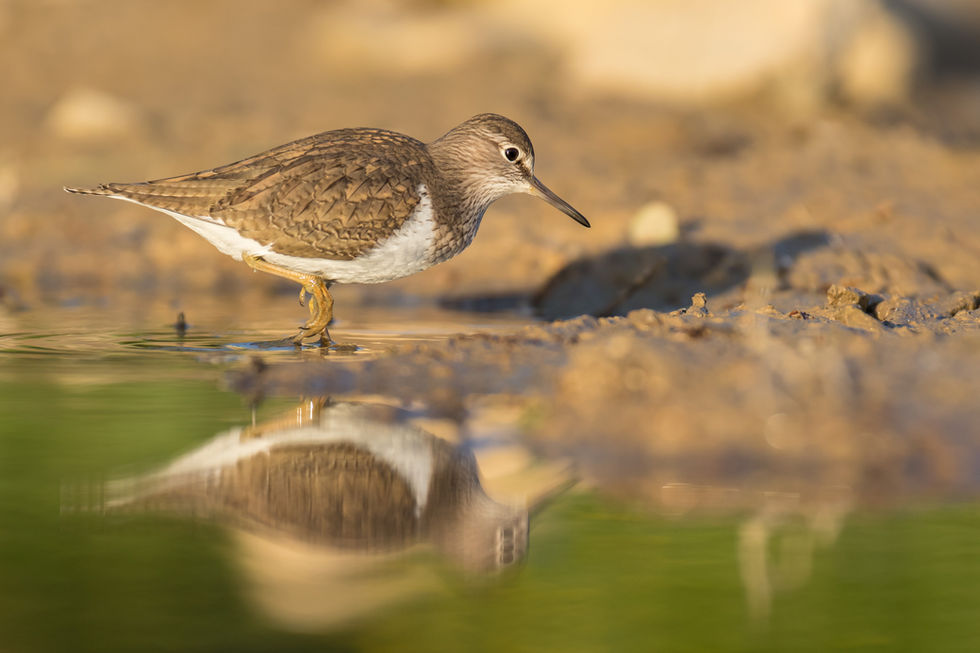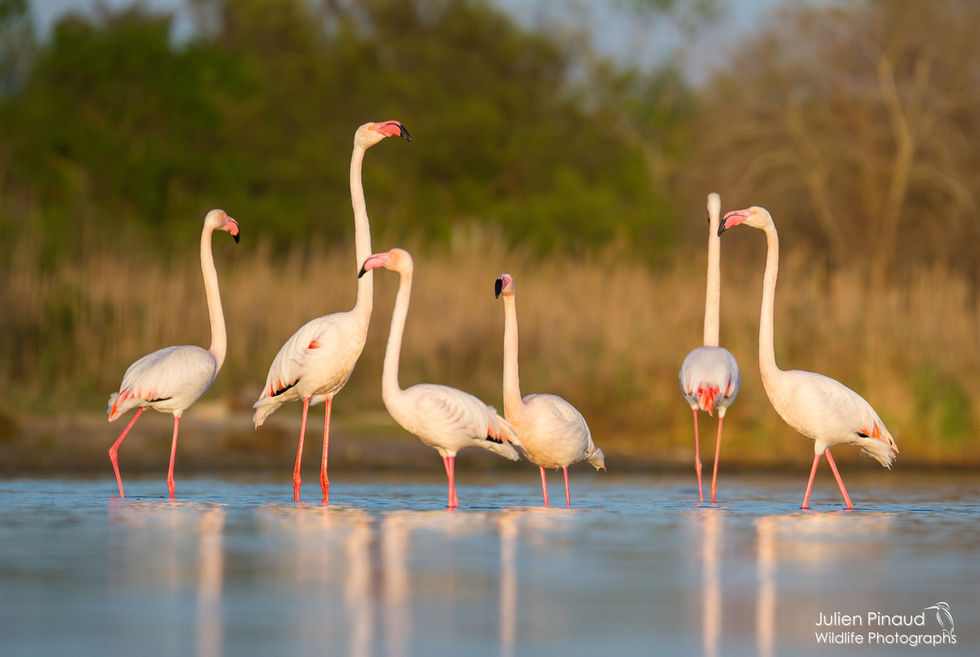
Vidourle : fleuve sauvage
Vidourle: wild river
Plus connu pour ses crues destructrices que pour la faune qu'il héberge, le Vidourle n'en reste pas moins l'un des derniers fleuves sauvage de France. Sur les quelques

Better known for its destructive floods than for the fauna it hosts, the Vidourle is nonetheless one of the last wild rivers in France. Along the 95 km that separate its source in
95 km qu'il parcourt entre la montagne de fage et la mer Méditerranée, il accueille une myriade d'espèces animales et végétales. Guépier d'Europe, castor d'Eurasie, héron cendré, crabier chevelu, flamant rose ou encore chevalier sylvain sont quelques-unes des espèces que je vous propose de découvrir au cours de cet article.
Le Vidourle prend sa source sur la commune de Saint-Roman de Codières. Il n'est alors qu'un simple torrent de montagne, et le restera jusqu'en aval de Saint-Hippolyte du fort, juste avant de s'enfoncer sous terre pour quelques kilomètres. Sur cette première portion, les eaux fraiches et limpides accueillent le cincle plongeur, la bergeronnette des ruisseaux ou encore de la truite fario. Quelques barrages ponctuent le cours de l'eau, faisant apparaître des cascades où le cincle plongeur aime y édifier son nid à la fin de l'hiver. Cet oiseau caractéristique des torrents présente la particularité de pêcher en marchant au fond de l'eau pour y attraper larves, petits goujons, alevins...
the fage mountain from the Mediterranean sea, a myriad of animal species live along its flow. European bee-eaters, Eurasian beavers, grey herons, squacco herons, pink flamingos or wood sandpipers are some of the species that you can see going down this river and that we will discover along this article.
The Vidourle takes its source in the commune of Saint-Roman de Codières. There, it is only a small mountain spring and remains so until Saint-Hippolyte du fort, just before the flow of the water go underground for some distance. Along these first kilometers, the fresh and clear waters of the Vidourle are home to the white-throated Deeper, the Grey Wagtail, but also to some trouts. From time to time, the flow of the water is interrupted by little dams that create waterfalls where the Deeper likes to build its nest. This bird, very characteristic of fresh and clean waters, fishes larvaes and small fish by walking underwater at the bottom of the river.


Au début du printemps, les rives "montagneuses" du Vidourle sont également l'hôte de quelques perces-neige qui viennent embellir les abords du fleuve de leur belles clochettes. Avec beaucoup de chance, vous y verrez aussi la loutre d'Europe passer de pierre en pierre. Vous pourrez observer beaucoup plus facilement la bergeronnette des ruisseaux avec son beau poitrail jaune vif et peut-être l'entendre s'égosiller pour séduire sa belle.
At the beginning of spring, the shores of this little mountain spring are a nice place to watch some snowdrop blooming. If you are very lucky, you might also see the elusive Eurasian Otter going from rock to rock with the flow of water. With her bright yellow chest, the Grey wagtail is much easier to spot. In case you can't locate it, just be attentive and you will certainly hear the male singing loudly to attract a female.
En peu plus en aval, le Vidourle se calme et prend des allures de rivière de plaine. Il n'empêche que les crues d'automne peuvent être dévastatrices sur cette portion de rivière, faisant vite oublier cet air paisible. Malgré les dommages qu'elles engendrent, elles permettent aussi d'éroder les rives au plus grand bonheur des guêpiers d'Europe. En effet, ceux-ci trouvent dans les falaises argilo-sableuse formées, un terrain idéal pour creuser leur terrier dès leur retour d'Afrique début Mai. Il arrive que ces terriers soient occupés par quelques moineaux soulcies opportunistes ou encore par quelques martin pécheurs d'Europe qui cohabitent sans difficulté avec les guépiers. C'est aussi à cette période que vous pourrez les observer parader et s'accoupler. Ce moment particulier est l'objet d'un rituel bien programmé. Le mâle commence par chasser un bel insecte (une libellule, une cigale ou encore un papillon). Il rejoint ensuite sa belle sur une branche bien stable, fini de tuer l'insecte en le tapant sur la branche et l'offre à sa promise. Si la proie lui convient, ils s'échangeront alors l'insecte du bout du bec. Il s'ensuivra un toilettage en bon est dû forme qui mènera à l'instant tant recherché: l'accouplement.
A little further downstream, the flows calm down, giving the Vidourle the appearence of a calm and lazy river. Don't be mistaken, the floods, often happening in autumn, can be devastating, taking with them, cars, bridges and sometimes people. Despite the damage they cause, they also erode the banks to the delight of the European bee-eaters. Indeed, they find in the clay-sandy cliffs formed, an ideal ground to dig their burrows as soon as they return from Africa at the beginning of May. Sometimes these burrows are occupied by a few opportunistic Rock sparrows or even by a few European kingfishers who easily coexist with the bee-eaters. It is also during this period that you will be able to observe them parading and mating. This particular moment is the object of a well programmed ritual. The male begins by chasing a beautiful insect (a dragonfly, a cicada or a butterfly). He then joins his beloved on a very stable branch, finishes killing the insect by hitting it on the branch and offers it to the female. If the prey suits her, they will then swap the insect with the tip of the beak. A meticulous grooming for both birds will follow, which will lead to the moment so much sought after: mating.
Lors des crues, la terre et les gravats arrachés à la rive forment des gravières où le Petit Gravelot aime à nicher. Elles servent également de reposoir à de nombreux oiseaux en migration ou qui viennent tout simplement pécher dans les eaux du Vidourle. D'autre part, afin de limiter les crues dévastatrices du Vidourle, différents barrages et retenues d'eau ont été construits à la fin des années 1960. Ces différents éléments créent ainsi une variété de milieux humides favorisant la biodiversité. Ainsi, les gravières et autres zones peu profondes du Vidourle attirent les hérons et les aigrettes qui viennent pêcher. Les eaux plus calmes et plus profondes en amont des barrages servent de lieu de pêche pour le Balbuzard en migration ou pour le Grand cormoran en hivernage. Aux abords des rives en pente douce, les roselières et zones de marécages hébergent les foulques macroules, les grèbes castagneux, les chevaliers sylvain et culblanc ou encore le Héron pourpré à son passage.
During the floods, the soil and the rubbles torned from the shore form gravel pits where the Little Plover likes to nest. They also serve as a resting place for many migrating birds or for those simply coming to fish in the waters of the Vidourle. On the other hand, in order to limit the devastating floods of the Vidourle, various dams and water reservoirs were built at the end of the 1960s. These various elements create a variety of wetlands favouring biodiversity. Thus, the gravel pits and other shallow areas of the Vidourle attract herons and egrets which come to fish. The calmer and deeper waters upstream of the dams are used as a fishing ground for migrating Ospreys or for wintering Great Cormorants. On the edge of the gently sloping banks, the reed beds and marshy areas are home to Coots, Little Grebes, Wood, Green and Common Sandpiper or even the Purple Heron as it passes by.
Tout au long de ces flots plus tranquilles, une ripisylve majoritairement constituée de saules et de peupliers s'est développée. C'est ainsi qu'une population de Castor d'Eurasie a pu s'établir en remontant de Camargue. Il arrive ainsi fréquemment de rencontrer quelques troncs d'arbres taillés en crayon ou encore quelques "tas" de branchages qui font office de hutte aux castors. Avec un peu de chance, vous en verrez peut-être un nager à la surface de l'eau à l'heure où la lumière se fait plus rare.
All along these calm waters, a riparian forest mainly made up of willows and poplars has developed. This is how a Eurasian Beaver population was able to settle up from the Camargue. It often happens to come across a few trunks of trees cut in pencil or even a few "piles" of branches which serve as a beaver lodge. With any luck, you might see some swimming on the surface of the water at a time when the light is scarcer.
Alors qu'autrefois le Vidourle terminait sa course dans l'étang de l'or et dans les marais de Saint-Laurent d'Aigouze, il se jette aujourd'hui dans la mer Méditerranée via le canal du Grau du Roi et l'étang du ponnant. Ce dernier, accueille régulièrement une avifaune typique de camargue avec Flamants rose, Hérons pourprés, Grèbes huppés ou encore Sternes Caspienne. En hiver, on peut également y observer quelques Grèbes à cou noir qui viennent passer la saison au chaud.
Whereas in the past the Vidourle ended its course in the "Etang de l'or" and in the marshes of Saint-Laurent d'Aigouze, it now flows into the Mediterranean Sea via the Grau du Roi canal and the "Etang du ponnant." The latter regularly hosts a typical Camargue avifauna with Pink Flamingos, Purple Herons, Crested Grebes and even Caspian terns. In winter, we can also observe some Black-necked Grebes which come to spend the season in the warmth.
Les différentes espèces présentées sur cette page ne représentent qu'une infime partie des animaux inféodés au Vidourle. Cette rivière est une véritable source de vie tout au long de l'année et plus particulièrement lors des mois d'été, où elle sert alors d'abreuvoir à bon nombre d'animaux (chevreuils, renards, oiseaux, insectes...). Il ne vous reste donc plus qu'à parcourir cette jolie rivière pour en découvrir un peu plus sur celle-ci.
The different species presented on this page represent only a small part of the animals subservient to the Vidourle. This river is a real source of life throughout the year and more particularly during the summer months, when it is used as a water source for a good number of animals (deer, foxes, birds, insects ...). So all you have to do is browse this pretty river to discover a little more about it.










































































